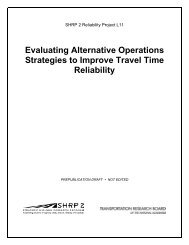Contemporary Approaches to Parking Pricing: - FHWA Operations
Contemporary Approaches to Parking Pricing: - FHWA Operations
Contemporary Approaches to Parking Pricing: - FHWA Operations
Create successful ePaper yourself
Turn your PDF publications into a flip-book with our unique Google optimized e-Paper software.
Case Studies<br />
7.0<br />
Aspen, Colorado<br />
The City of Aspen is a well-known resort community in Colorado and offers an informative example of a <strong>to</strong>wn that<br />
has implemented paid, escalating parking charges; integrated numerous payment technologies; funded commuter<br />
programs with parking revenue; and priced parking in RPP zones. The <strong>to</strong>wn’s population is relatively small, but its<br />
scenic location, access <strong>to</strong> multiple ski resorts, and high-end shopping and dining make it a major <strong>to</strong>urist destination.<br />
Faced with a significant number of vehicle trips, limited roadway and parking capacity, and a desire <strong>to</strong> reduce the<br />
environmental impacts associated with vehicle travel, the city turned <strong>to</strong> numerous parking management strategies<br />
<strong>to</strong> reduce vehicle trips.<br />
Aspen implemented paid parking in its down<strong>to</strong>wn in 1995 <strong>to</strong> increase parking availability. City planners recommended<br />
an hourly rate of $1.00, time limits of 2 hours, and residential parking permits <strong>to</strong> protect adjacent neighborhoods.<br />
It was further recommended that the parking changes be implemented concurrently with a doubling of<br />
bus service, expansion of high occupancy vehicle lane miles, and the establishment of convenient, mid-block pay<br />
stations and in-car meters. This plan generated a significant amount of negative public reaction. In response, the<br />
city council, while approving the plan, agreed <strong>to</strong> put it <strong>to</strong> a vote via a binding public referendum, but only after paid<br />
parking and the plan’s other elements had been in place for 3 months. When the vote occurred, 75 percent of voters<br />
supported continuation of the program.<br />
The manner in which Aspen handles its RPP zones is unique. The zones were created <strong>to</strong> prevent overflow parking<br />
from the city’s down<strong>to</strong>wn core. Residents are provided with parking permits and visi<strong>to</strong>rs are allowed <strong>to</strong> park for free<br />
for up <strong>to</strong> 2 hours in an 8-hour period. Those two policies alone would result in occupancy rates below 85 percent.<br />
To assure that its on-street parking facilities are appropriately utilized, the city allows visi<strong>to</strong>rs wishing <strong>to</strong> park for<br />
more than 2 hours <strong>to</strong> purchase $7.00 day passes at a local grocery s<strong>to</strong>re, through a pay-by-phone service, or at any of<br />
the 15 pay stations located within the neighborhoods. Businesses within the RPP neighborhoods are allowed <strong>to</strong><br />
purchase business vehicle permits. Each permit can be used in any vehicle and costs $1,000 per year. Lodges within<br />
RPP neighborhoods are eligible <strong>to</strong> purchase parking permits for their guests’ use. Employees at lodges were using<br />
the permits for personal parking, however, forcing the city <strong>to</strong> implement a “two strikes” policy in which any lodge<br />
whose employees are caught twice abusing the program are banned from participating; this dramatically increased<br />
compliance.<br />
The city regularly moni<strong>to</strong>rs parking availability in residential neighborhoods. If average occupancy in the neighborhoods<br />
exceeds 85 percent over a 1-year period, rates are increased.<br />
As the down<strong>to</strong>wn parking policy matured, it became apparent that many visi<strong>to</strong>rs wanted <strong>to</strong> park for more than 2<br />
hours. This demand was met through the implementation of a progressive rate structure that extended parking<br />
limits <strong>to</strong> 4 hours. The cost of the first 2 hours remained unchanged and drivers were allowed <strong>to</strong> purchase an additional<br />
2 hours of parking for a premium charge. By keeping the cost of the first 2 hours of parking unchanged the<br />
city was able <strong>to</strong> avoid significant negative response from the community. While some individuals expressed concern<br />
regarding the higher rates for the third and fourth hours, the ability of the program <strong>to</strong> offer drivers more options<br />
C o n t e m p o r a r y A p p r o a c h e s t o P a r k i n g P r i c i n g | 33















